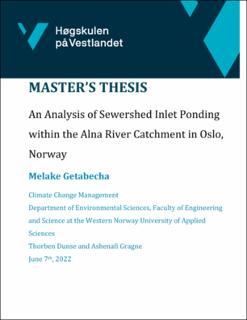| dc.description.abstract | The risks associated with urban flooding are increasing in response to global climate change, urbanization, and inadequate stormwater infrastructure. This rapidly increasing risk requires that cities across the globe respond through action geared at mitigating and adapting to changing hydrology of their surroundings. In order for this action to be effective, decision-makers need information that helps them understand, explain, and predict the current state of their urban hydrodynamics.
This study focuses on improving the accuracy of the Alna Catchment System’s Stormwater Management Model (SWMM), based in Oslo, Norway, by adding ponding data and assessing the impacts this data has on the model. Ponding data is acquired using a Geographic Information System (GIS) based terrain analysis which measures the potential ponding capacity surround each stormsewer inlet within the study are.
The results revealed that 4% of the stormsewer inlets have ponding capacity of varying sizes and when their location and dimensions are entered into the model, they have a substantial impact on modeling results. Of the 9 different rain scenarios the model was run under, 4 scenarios saw a 100% reduction in Flood Loss (i.e. rain-based runoff whose end destination was undetermined) when ponding data was entered.
The ponds were determined to have the highest impact in reducing Flood Loss during rain scenarios with return periods of 2-years, and 20-years, and durations of 20 minutes as well as scenarios with 200-year return periods and durations of 60 minutes and 1440 minutes. The addition of ponding data also resulted in an increase in modeled nodes experiencing flooding for all 9 rain scenarios and less Total Flooding Volume for 8 of the scenarios. The GIS-based terrain analysis proved an effective method to identify potential inlet ponds, and the addition of ponding data provided an increased understanding of how inlet ponding impacts the Alna Hydrological System. | en_US |

